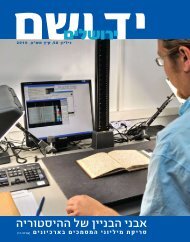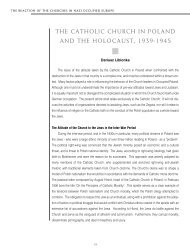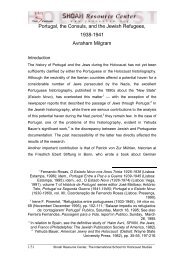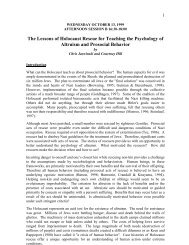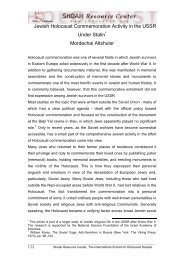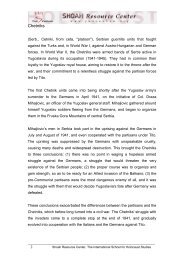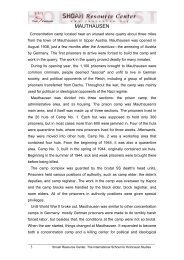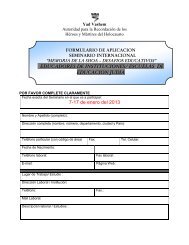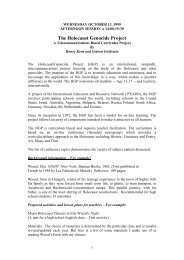Magazine 48 - Winter 2008 - Yad Vashem
Magazine 48 - Winter 2008 - Yad Vashem
Magazine 48 - Winter 2008 - Yad Vashem
Create successful ePaper yourself
Turn your PDF publications into a flip-book with our unique Google optimized e-Paper software.
y Leah Goldstein<br />
More than any other place in the world, <strong>Yad</strong> <strong>Vashem</strong> is the natural repository for ITS material.<br />
Ultimately, our visit here will allow the material in Bad Arolsen to be put to the best and<br />
widest use possible.”<br />
ITS Director Reto Meister at <strong>Yad</strong> <strong>Vashem</strong>, May 2007<br />
In November 2007, the 11 member states of the International Commission of the International<br />
Tracing Service (ITS) ratified a new agreement whereby scanned copies of the millions of WWIIrelated<br />
documents currently housed in Bad Arolsen, Germany will be released to the general public.<br />
This process will take place in a number of stages over the next three years, and will help survivors,<br />
members of the next generations, researchers and historians in their quest to discover more information<br />
about the war and its victims.<br />
In light of this historic event, the new Director of <strong>Yad</strong> <strong>Vashem</strong>’s Archives, Dr. Haim Gertner,<br />
was interviewed about <strong>Yad</strong> <strong>Vashem</strong>’s long-standing relationship with the ITS, and how this new<br />
development will affect Holocaust remembrance and research in the coming years:<br />
..........................<br />
What kind of information war,” the Allies gathered all the documentation<br />
do <strong>Yad</strong> <strong>Vashem</strong>’s Archives possible that pertained to individuals during<br />
currently hold?<br />
WWII—including victims, deportations,<br />
With some 75 million pages of<br />
concentration camps, forced labor and displaced<br />
documentation, <strong>Yad</strong> <strong>Vashem</strong>’s archives comprise<br />
persons. Since a large proportion of the ITS<br />
the largest collection of information on the<br />
documentation included first-hand evidence<br />
Holocaust, as well as photographs, testimonies,<br />
of the fate of Jewish victims of Nazism, the<br />
Pages of Testimony and more. Sources of this<br />
Israeli government requested permission in<br />
information include documentation microfilmed<br />
the early 1950s to photograph the sections of<br />
by Israel in the mid-1950s at Bad Arolsen,<br />
the ITS collection relating to Jewish suffering<br />
Germany, in the central repository of the<br />
during WWII. Permission was granted, and<br />
International Tracing Service (ITS) established<br />
from June 1955-November 1957 a project<br />
at the end of WWII to help survivors trace<br />
was run by a team of experts at <strong>Yad</strong> <strong>Vashem</strong><br />
missing relatives and friends.<br />
to microfilm some 20 million pages of<br />
documents with information about Jewish<br />
victims, as well as items of specific Jewish<br />
When did <strong>Yad</strong> <strong>Vashem</strong> first<br />
interest, which were then placed for permanent<br />
acquire documents from<br />
storage in its archives. Thus <strong>Yad</strong> <strong>Vashem</strong> became<br />
the ITS? Why?<br />
the only place in the world other than Bad<br />
In charging the ITS with its enormous Arolsen to hold copies of ITS documentation.<br />
task to help reunite families “torn apart by Over the years, <strong>Yad</strong> <strong>Vashem</strong> has also provided<br />
the ITS with copies of various collections in its<br />
archives.<br />
............. .....................................................................................<br />
“<br />
4<br />
The International<br />
Committee of the ITS<br />
recently signed a new<br />
agreement whereby<br />
scanned copies of the<br />
entire archive will be<br />
transferred to its 11<br />
member states –<br />
including Israel – over<br />
the next three years.<br />
............................................................<br />
How has <strong>Yad</strong> <strong>Vashem</strong> helped<br />
with searches for<br />
information on Holocaust<br />
victims?<br />
Over the past half century, <strong>Yad</strong> <strong>Vashem</strong><br />
has amassed unrivaled research and technical<br />
skills, answering some 25,000 annual requests<br />
for information about Holocaust victims. As<br />
<strong>Yad</strong> <strong>Vashem</strong> held a copy of much of the ITS<br />
Holocaust-period documents, many people<br />
turned to us for information even if they knew<br />
the original source was in the ITS. Over the<br />
decades, experts here have thus helped<br />
thousands of members of the public in the<br />
complicated search for information stored on<br />
these microfilms, as well as from other sources<br />
in our vast archives. Our Central Database of<br />
Shoah Victims’ Names on <strong>Yad</strong> <strong>Vashem</strong>’s<br />
website, visited by some seven million people<br />
in 2007, also holds much information on<br />
Holocaust victims.<br />
How is the material now<br />
being released different<br />
from what <strong>Yad</strong> <strong>Vashem</strong><br />
already has?<br />
Due to mounting public pressure to allow<br />
easier access to the vital documentation housed<br />
at Bad Arolsen, the International Commission<br />
of the ITS recently signed a new agreement<br />
whereby digital copies of the entire collection<br />
will be transferred to its 11 member states—<br />
Israel, Belgium, France, Great Britain, Italy,<br />
Luxembourg, the Netherlands, the United<br />
Dr. Haim Gertner: “<strong>Yad</strong> <strong>Vashem</strong> will continue to<br />
respond to each public enquiry with as comprehensive<br />
an answer as possible.”<br />
States, Germany, Greece and Poland—over<br />
the next three years. Israel’s representative to<br />
receive the documentation is <strong>Yad</strong> <strong>Vashem</strong>; the<br />
United States Holocaust Memorial Museum<br />
(USHMM) is the repository in the US; and<br />
in Poland, the IPN (Institute of National<br />
Memory) will receive the copies. Much of this<br />
material duplicates what we already hold, but<br />
it also includes additional material collected in<br />
the last 50 years by the ITS as well as documents<br />
not copied at that time.<br />
What is the Central Names<br />
Index?<br />
Among the ITS documents photographed by<br />
<strong>Yad</strong> <strong>Vashem</strong> in the 1950s were the 16 million<br />
reference cards that made up the so-called<br />
“Central Names Index” (CNI—previously<br />
known as the “Master Index”). Each of these<br />
cards bears information on every appearance<br />
of a person on any original document in the<br />
ITS, and a reference to that document. Over<br />
the years the number of these cards increased,



